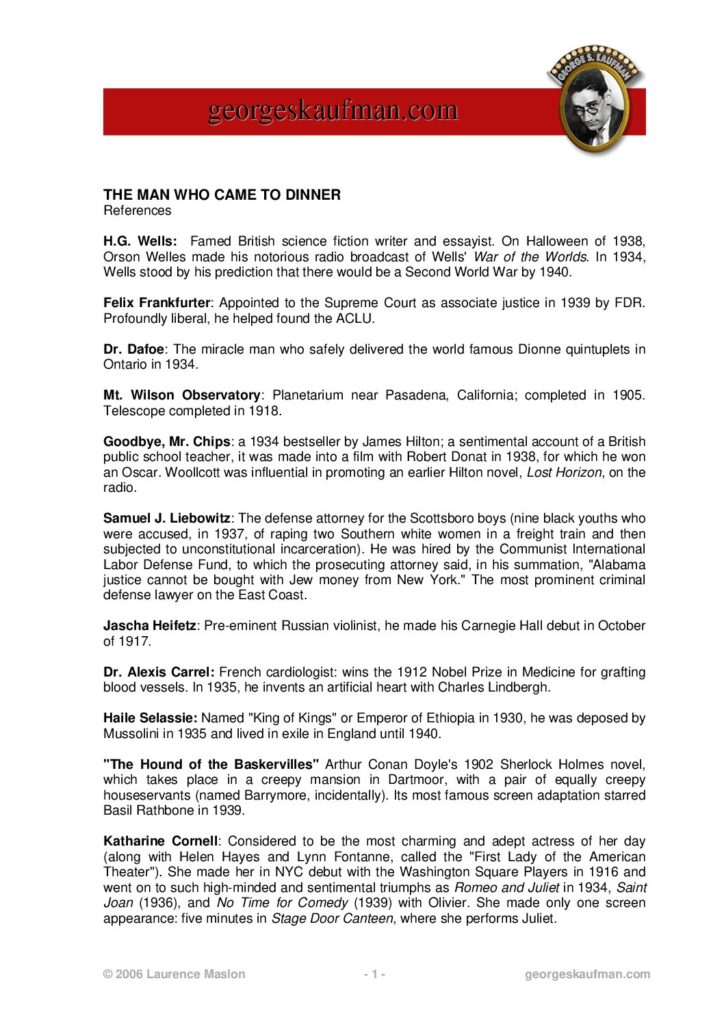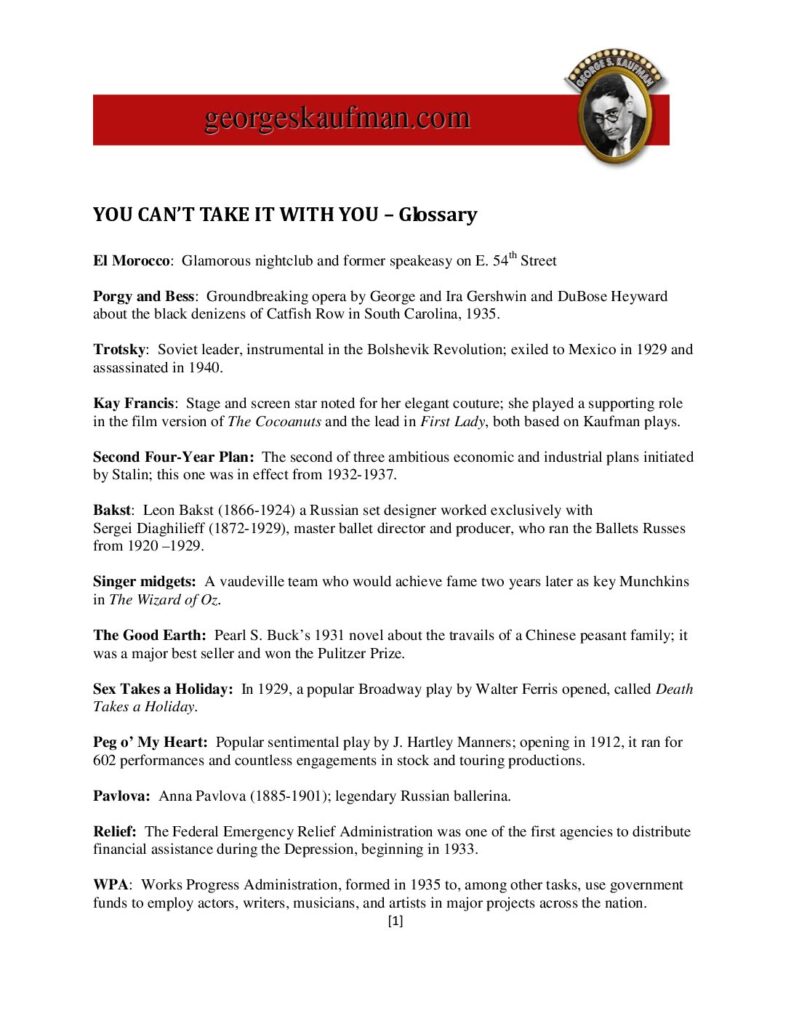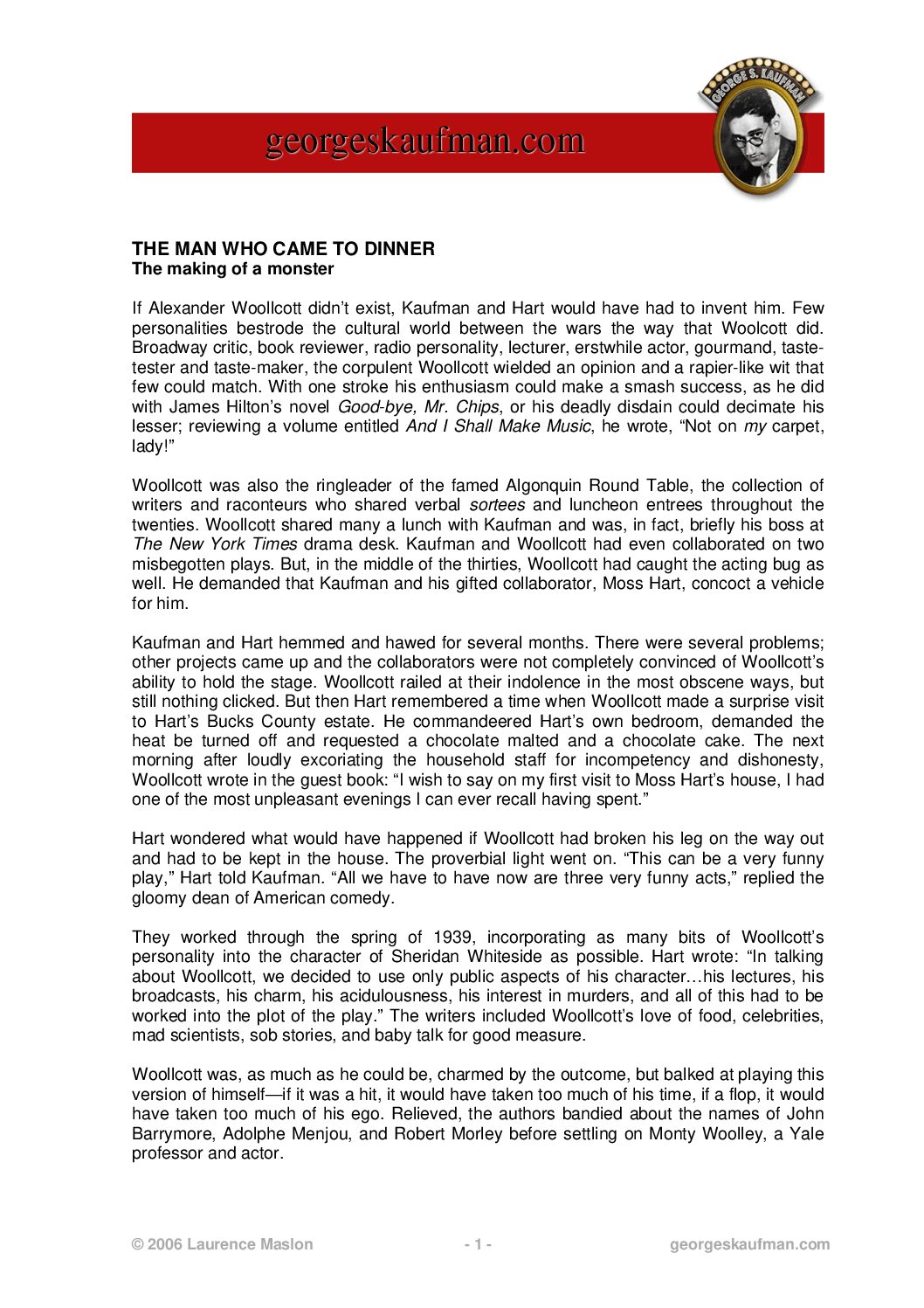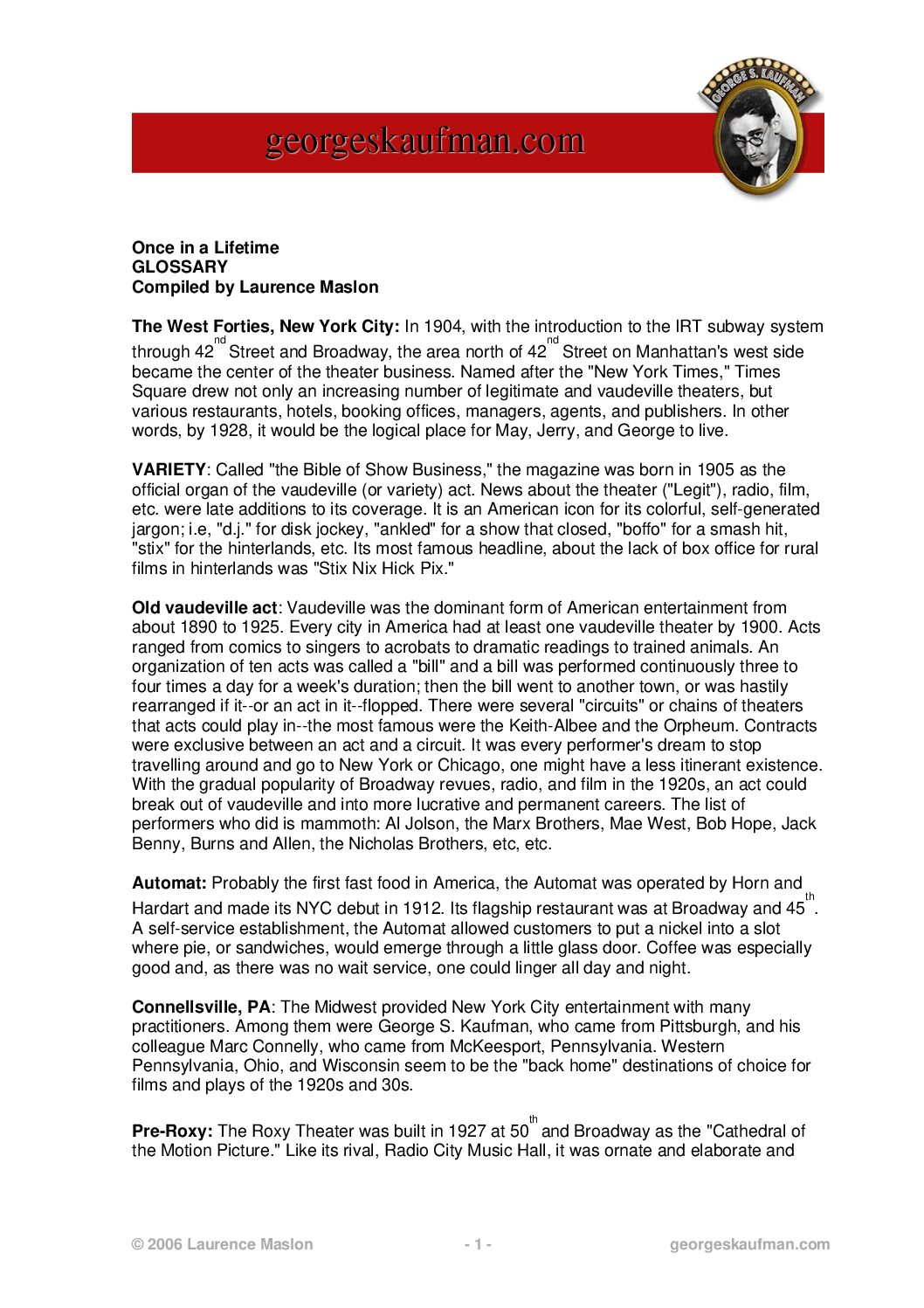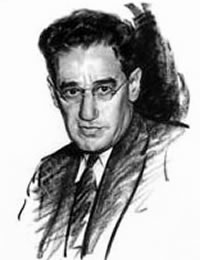The Best of Families
The Best of Families
From the George S. Kaufman Archive
The Best of Families
By Laurence Maslon
“All happy families resemble one another, but each unhappy family is unhappy in its own way,” wrote Tolstoi in Anna Karenina, but then again, he never met the Vanderhof family. The Vanderhof family, the idiosyncratically jolly clan at the center of the whirlwind known as You Can’t Take It With You, couldn’t possibly resemble another family–and therein lies much of the charm of Kaufman and Hart’s comedy. But Kaufman and Hart’s basic conception of this family–and the nature of families in general–strikes at something very deep in the American character.
It’s worth remembering that the three finest plays in American literature are all about families: Thornton Wilder’s Our Town (an eternal family), O’Neill’s Long Day’s Journey into Night (an unhappy family), and You Can’t Take It With You (a happy family). Clearly, the idea of family remains a preoccupation in American drama, yet none of the four authors had a conventional American family upbringing. Of course, each of the plays also challenges the notion that there is such a thing as a conventional American family upbringing.
George S. Kaufman and Moss Hart, for all the sophistication they came to embody, were two Jews born into less-than-ideal circumstances far from the bright lights and silver spoons of Manhattan. Kaufman was born in Pittsburgh in 1889 to a family that, according to him, “managed to get in on every business as it was finishing and made a total of $4 among them.” His father, Joseph, managed to raise his family just fine, but had a penchant for leaving one career and starting a completely different one with alarming frequency. Moss Hart was born in the Bronx in 1904 and “grew up in an atmosphere of unrelieved poverty” with “the grim smell of actual want always at the end of my nose,” as his writes in his memoir Act One. His beloved childhood idol was his eccentric Aunt Kate, who lived as if she were in the Belle Epoque and always went into Manhattan to the theater, no matter how strapped the family was. One hears the strains of Joseph Kaufman and Aunt Kate in the voices of Grandpa Vanderhof and Penny Sycamore.
By the time they wrote You Can’t Take It With You in 1936, Kaufman and Hart were at the height of their powers. The team came together in 1930 over Hart’s idea for a Hollywood farce called Once In a Lifetime and in 1934 they wrote an epic about American history and show biz, Merrily We Roll Along. Lured frequently to Hollywood itself in the 1930s (although “dragged kicking and screaming” is more accurate in Kaufman’s case), the team managed to find some time in Los Angeles to collaborate on a play during the summer of 1936. They rejected a political farce and worked around the relatively plotless, character-driven story of a “slightly mad family,” as Kaufman put it in a letter to his wife. “But it has a point,” he continued, “as you can see–that the way to live and be happy is just to go ahead and live, and not pay attention to the world.”
This was pretty good advice back in 1936. Although Roosevelt had not yet been re-elected when the play was written, the nation was still working out the kinks of the New Deal. The effort on the part of the Roosevelt Administration to put the nation back on its feet was immense, but the country was struggling after seven years of the Depression. Kaufman and Hart were good New York Jewish show business liberals, and at times, Kaufman inclined towards the socialist side–he had voted for the Socialist presidential candidate Norman Thomas in 1932 and contributed a number of humorous essays to the Nation and the New Masses. The Vanderhofs are a distinctly Depression family–several of them are on relief and, clearly, it’s Socialism on the home front. But the genius of the play is that it pits one kind of Depression family against another: the Kirbys, a well-heeled patrician exemplar of disciplined self- government in one corner against the Vanderhofs, a wacky, devil-may-care extended family of eccentrics. The Adams family versus the Addams Family, if you will.
It’s important to remember that among the patrician world of America, Franklin D. Roosevelt himself was seen as a traitor to his class. He came from an old Dutch family, wealthy, connected, one of them–and here he was, radiating bonhomie over the airwaves into the average fellow’s living room, meddling in free enterprise, soaking the rich, for goodness’ sake. A famous Peter Arno cartoon from the New Yorker in the 1930s depicts a gleeful group of boiled-shirt and ermine clad plutocrats–the Kirbys–calling on another group through their townhouse window: “Come along! We’re going to the Trans-Lux to hiss Roosevelt!” In short, the thing that galled the upper classes was that Roosevelt was born a Kirby, but behaved like Grandpa Vanderhof. But the Kirbys of the world did build this country financially, behaved responsibly for the most part, and carried the torch for capitalism. When Mr. Kirby labels the Vanderhof point of view “Un-American,” he’s right–but only half-right.
For the Vanderhof strain, what critic Dwight MacDonald called “Against the American Grain,” is the other half of the American character. This country was, after all, founded by religious “eccentrics” who came here to worship in their own way, contrary to the dominant culture of their time. American history is full of people who defied convention–the Pilgrims, the Brook Farm utopian experiment in the 1840s, the Donner Party (well, maybe we’ll let that pass), Eugene V. Debs (whom Kaufman admired), the Hollywood Ten, the sit-in organizers of the Civil Rights era, the hippies, the yippies. Even the Clintons, as Barbara Mikulski reminded us, were protesters once. What literary character is more axiomatic of America than Huckleberry
Finn, who turned his back on “civilization,” set out on a river, and, against all rules and laws, called a black man his friend? One only has to think of Yossarian, who fights madness with madness in Catch-22, or of Dustin Hoffman’s character in The Graduate to see that the archetype is still with us.
Ironically, after You Can’t Take it With You (which is one of the few comedies to have won a Pulitzer Prize), Kaufman and Hart turned their sights on Roosevelt himself, in a musical satire, called I’d Rather Be Right, which spoofed both the New Deal and its critics. But in this play, easily their most famous and definitely their most successful, the team gave us an even better time capsule of American values during the Depression. In the 1930s, America really had to choose what kind of nation it was going to be, and Kaufman and Hart laid out the choice pretty clearly: on one side of the coin, the Protestant work ethic, the responsibility of capitalism; on the other side of the coin, rugged individualism, the lure of personal freedom. You can say what you like about the other side of the coin–and many parents have, when their children have been in their rebellious stage–but you can’t say it’s “Un-American.” No, sir.
Laurence Maslon is an associate arts professor at NYU’s Tisch School of the Arts. He is the editor of Kaufman & Co. for the Library of America.
Copyright 2006.
By Laurence Maslon
“All happy families resemble one another, but each unhappy family is unhappy in its own way,” wrote Tolstoi in Anna Karenina, but then again, he never met the Vanderhof family. The Vanderhof family, the idiosyncratically jolly clan at the center of the whirlwind known as You Can’t Take It With You, couldn’t possibly resemble another family–and therein lies much of the charm of Kaufman and Hart’s comedy. But Kaufman and Hart’s basic conception of this family–and the nature of families in general–strikes at something very deep in the American character.
It’s worth remembering that the three finest plays in American literature are all about families: Thornton Wilder’s Our Town (an eternal family), O’Neill’s Long Day’s Journey into Night (an unhappy family), and You Can’t Take It With You (a happy family). Clearly, the idea of family remains a preoccupation in American drama, yet none of the four authors had a conventional American family upbringing. Of course, each of the plays also challenges the notion that there is such a thing as a conventional American family upbringing.
George S. Kaufman and Moss Hart, for all the sophistication they came to embody, were two Jews born into less-than-ideal circumstances far from the bright lights and silver spoons of Manhattan. Kaufman was born in Pittsburgh in 1889 to a family that, according to him, “managed to get in on every business as it was finishing and made a total of $4 among them.” His father, Joseph, managed to raise his family just fine, but had a penchant for leaving one career and starting a completely different one with alarming frequency. Moss Hart was born in the Bronx in 1904 and “grew up in an atmosphere of unrelieved poverty” with “the grim smell of actual want always at the end of my nose,” as his writes in his memoir Act One. His beloved childhood idol was his eccentric Aunt Kate, who lived as if she were in the Belle Epoque and always went into Manhattan to the theater, no matter how strapped the family was. One hears the strains of Joseph Kaufman and Aunt Kate in the voices of Grandpa Vanderhof and Penny Sycamore.
By the time they wrote You Can’t Take It With You in 1936, Kaufman and Hart were at the height of their powers. The team came together in 1930 over Hart’s idea for a Hollywood farce called Once In a Lifetime and in 1934 they wrote an epic about American history and show biz, Merrily We Roll Along. Lured frequently to Hollywood itself in the 1930s (although “dragged kicking and screaming” is more accurate in Kaufman’s case), the team managed to find some time in Los Angeles to collaborate on a play during the summer of 1936. They rejected a political farce and worked around the relatively plotless, character-driven story of a “slightly mad family,” as Kaufman put it in a letter to his wife. “But it has a point,” he continued, “as you can see–that the way to live and be happy is just to go ahead and live, and not pay attention to the world.”
This was pretty good advice back in 1936. Although Roosevelt had not yet been re-elected when the play was written, the nation was still working out the kinks of the New Deal. The effort on the part of the Roosevelt Administration to put the nation back on its feet was immense, but the country was struggling after seven years of the Depression. Kaufman and Hart were good New York Jewish show business liberals, and at times, Kaufman inclined towards the socialist side–he had voted for the Socialist presidential candidate Norman Thomas in 1932 and contributed a number of humorous essays to the Nation and the New Masses. The Vanderhofs are a distinctly Depression family–several of them are on relief and, clearly, it’s Socialism on the home front. But the genius of the play is that it pits one kind of Depression family against another: the Kirbys, a well-heeled patrician exemplar of disciplined self- government in one corner against the Vanderhofs, a wacky, devil-may-care extended family of eccentrics. The Adams family versus the Addams Family, if you will.
It’s important to remember that among the patrician world of America, Franklin D. Roosevelt himself was seen as a traitor to his class. He came from an old Dutch family, wealthy, connected, one of them–and here he was, radiating bonhomie over the airwaves into the average fellow’s living room, meddling in free enterprise, soaking the rich, for goodness’ sake. A famous Peter Arno cartoon from the New Yorker in the 1930s depicts a gleeful group of boiled-shirt and ermine clad plutocrats–the Kirbys–calling on another group through their townhouse window: “Come along! We’re going to the Trans-Lux to hiss Roosevelt!” In short, the thing that galled the upper classes was that Roosevelt was born a Kirby, but behaved like Grandpa Vanderhof. But the Kirbys of the world did build this country financially, behaved responsibly for the most part, and carried the torch for capitalism. When Mr. Kirby labels the Vanderhof point of view “Un-American,” he’s right–but only half-right.
For the Vanderhof strain, what critic Dwight MacDonald called “Against the American Grain,” is the other half of the American character. This country was, after all, founded by religious “eccentrics” who came here to worship in their own way, contrary to the dominant culture of their time. American history is full of people who defied convention–the Pilgrims, the Brook Farm utopian experiment in the 1840s, the Donner Party (well, maybe we’ll let that pass), Eugene V. Debs (whom Kaufman admired), the Hollywood Ten, the sit-in organizers of the Civil Rights era, the hippies, the yippies. Even the Clintons, as Barbara Mikulski reminded us, were protesters once. What literary character is more axiomatic of America than Huckleberry
Finn, who turned his back on “civilization,” set out on a river, and, against all rules and laws, called a black man his friend? One only has to think of Yossarian, who fights madness with madness in Catch-22, or of Dustin Hoffman’s character in The Graduate to see that the archetype is still with us.
Ironically, after You Can’t Take it With You (which is one of the few comedies to have won a Pulitzer Prize), Kaufman and Hart turned their sights on Roosevelt himself, in a musical satire, called I’d Rather Be Right, which spoofed both the New Deal and its critics. But in this play, easily their most famous and definitely their most successful, the team gave us an even better time capsule of American values during the Depression. In the 1930s, America really had to choose what kind of nation it was going to be, and Kaufman and Hart laid out the choice pretty clearly: on one side of the coin, the Protestant work ethic, the responsibility of capitalism; on the other side of the coin, rugged individualism, the lure of personal freedom. You can say what you like about the other side of the coin–and many parents have, when their children have been in their rebellious stage–but you can’t say it’s “Un-American.” No, sir.
Laurence Maslon is an associate arts professor at NYU’s Tisch School of the Arts. He is the editor of Kaufman & Co. for the Library of America.
Copyright 2006.
More from the
George S. Kaufman Archive
Contact Us Today
Interested in bringing George S. Kaufman’s timeless plays to your stage?
Please refer to the contact information for each specific play on the various collection pages for direct amateur and professional licensing information.
Plays are represented by Concord Theatricals, Broadway Dramatic Licensing, and Music Theatre International respectively
If you are interested in first-class performance or film/television rights:
In the US, George S. Kaufman’s plays are represented by:
CPK Artists, LLC
In the UK, George S. Kaufman’s plays are represented by:
Alan Brodie Representation
For more information about George S. Kaufman or this website, contact:
Laurence Maslon
Literary Trustee, George S. Kaufman Estate

